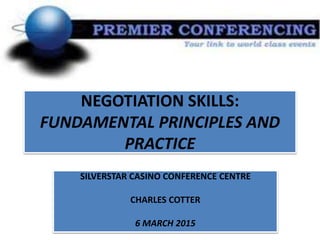
Master Negotiation Skills
- 1. NEGOTIATION SKILLS: FUNDAMENTAL PRINCIPLES AND PRACTICE SILVERSTAR CASINO CONFERENCE CENTRE CHARLES COTTER 6 MARCH 2015
- 2. TRAINING PROGRAMME OVERVIEW • Demonstrate an understanding of the theoretical aspects regarding negotiation • Identify the characteristics and key skills of effective negotiators • Differentiate between the negotiation styles • Differentiate between the types of negotiation • Apply the P-A-C model to negotiation • Identify and apply the core elements of the 4-phase negotiation process
- 3. FUNDAMENTALS OF NEGOTIATION • Defining negotiation • Characteristics of effective negotiators • Key skills of negotiators • Negotiation styles
- 4. DEFINING NEGOTIATION • Negotiation is a process centered on a discussion that is intended to produce an agreement. • In its simplest form, it could be considered to be about power. More than just about money, it involves issues of ego, leveraging, saving face, and being right. It can appear that the negotiator or team with the most power will triumph over a weaker team or win something important. • In current business practices, however, negotiation often leads to compromises, where both sides make concessions to get as close as they can to exactly what they want. Other times, no concessions are available and a power struggle can go on for a long time. • When negotiation is not effective, there are other options, such as bringing in a mediator, which can help both sides speak to one another and move towards a resolution instead of walking away and resolving nothing.
- 5. THE VALUE OF CONSTRUCTIVE NEGOTIATION
- 8. BEING ASSERTIVE AS A NEGOTIATOR
- 10. KEY SKILLS FOR NEGOTIATION SUCCESS • Allow for Creative Flexibility • Prepare • Know the Role of Value – Creating and Claiming Value • Understand Negotiating Styles – Co-operative vs. Competitive negotiators • Manage the Process • Handling Relationships • Learning • Word about Experience
- 13. TYPES OF NEGOTIATION • Integrative/Distributive • Inductive/Deductive/Mixed • Soft/Hard/Principled • Alternative Dispute Resolution (ADR) • Non-Negotiable Positions/Options
- 17. PHASE 1: PREPARATION • Preparatory points to consider • Ground rules • Identifying your Hot Buttons • Doing Research • Identifying Your Walk Away Position (WAP) • Identifying Your Best Alternative to a Negotiated Agreement (BATNA) • Working within the Zone of Possible Agreement (ZOPA)
- 19. WORKING WITHIN THE ZONE OF POSSIBLE AGREEMENT (ZOPA)
- 21. STEP 2: EXCHANGING INFORMATION • What information is held in common to both negotiating parties? • What information you will disclose? • What information you would prefer the other negotiating party to disclose?
- 22. STEP 3: BARGAINING • Responding to Challenges • Creating win-win solutions
- 24. RESPONDING TO CHALLENGES • Ways to Stay Calm • Detach Yourself from the Outcome • Include Pre-determined Break Times in Your Rules • Depersonalize the Process • Work with the Other Party, Not Against Them • Unspoken Conversations • Don’t Bring Your Baggage to the Table • Avoid Power Struggles • Stay Focused • Focus on a Positive Process
- 26. CREATING WIN-WIN SOLUTIONS • Keeping an Open Mind • Long Term and Short Term Relationships • Making the Most of Brainstorming • Thinking outside the Box • Use Your Resources (Experts, Mediators, Third Parties) • Meta-Negotiation • Identify Common Ground
- 28. STEP 4: COMMITMENT AND CLOSING • Once the parties have completed bargaining, made all the adjustments, and agreed upon the least uncomfortable result, the negotiation is ready for commitment and closure. • Developing a Sustainable Agreement What is a Sustainable Agreement? Getting everyone’s Perspective Reviewing the Information Outlining the Options Gaining Consensus
- 29. ROLE-PLAY: “THE UGLI ORANGE” • Refer to Learning Activity 12 • The facilitator will provide you with detailed learning instructions. • Apply what you’ve learnt the past two days about conflict resolution and negotiation to reach a mutually beneficial (win-win) agreement.
- 30. CONCLUSION • Key points • Summary • Questions
- 31. CONTACT DETAILS • Charles Cotter • (+27) 84 562 9446 • charlescot@polka.co.za • LinkedIn • Twitter: Charles_Cotter
